Gold, Guns and God, Vol. 9: Pushed Out Completely
A Biography of Swami Bhaktipada and a History of the West Virginia New Vrindaban Hare Krishna Community in Ten Volumes, by Henry Doktorski
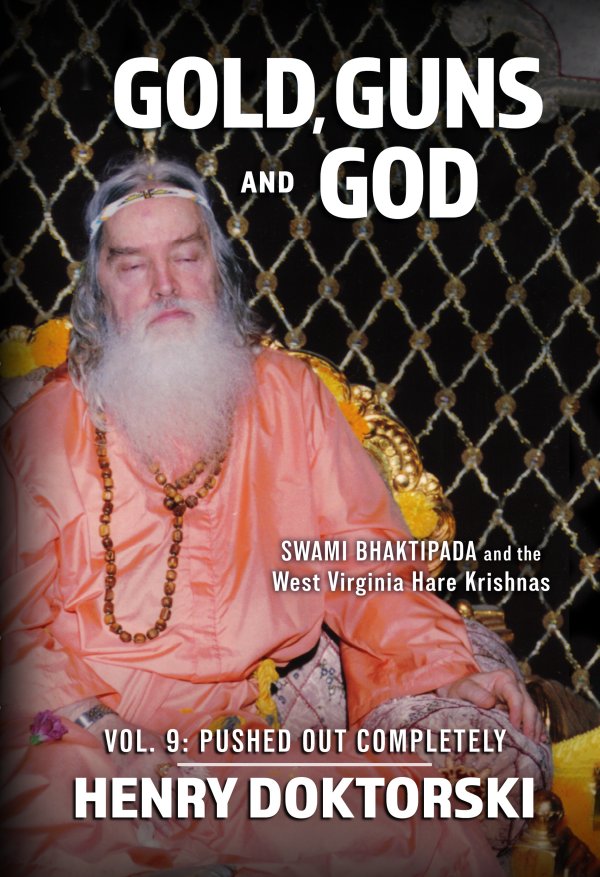
Gold, Guns and God, Vol. 9 front cover
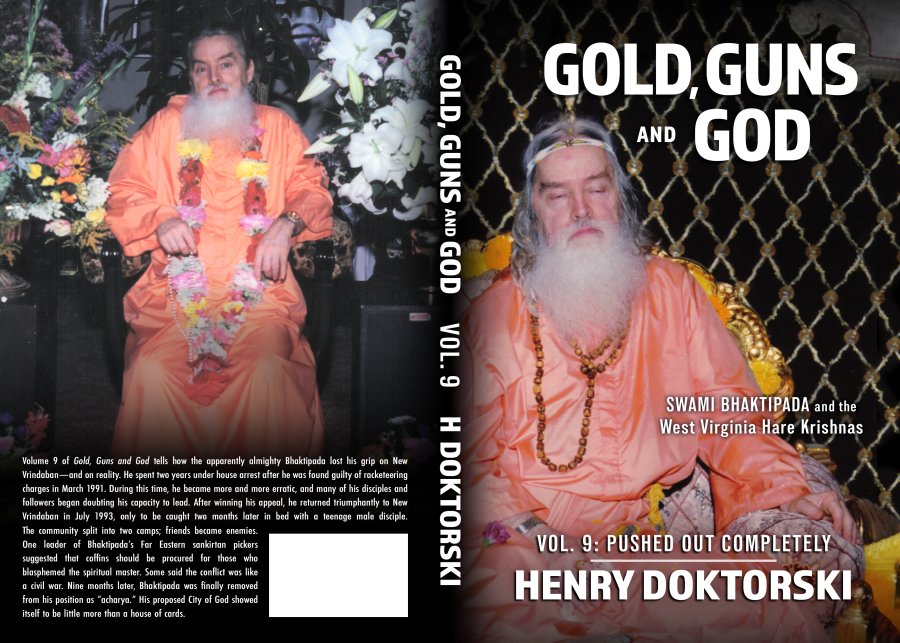
Gold, Guns and God, Vol. 9 front and back cover
Henry Doktorski’s landmark 386-page non-fiction book about Swami Bhaktipada and the West Virginia Hare Krishna commune called New Vrindaban, can be purchased in several ways:
(1) Save money and purchase directly from the author: Send a check or money order (or use PayPal or Venmo) for $19.99 (includes shipping to anywhere in the United States). Send an email to the author and request address. Credit card payments must go through PayPal or Venmo. Send PayPal payment to the author at the e-mail address listed below. Canadian and overseas customers can pay with Western Union and must inquire directly from the author regarding shipping prices.
(3) In USA, purchase from Amazon.com.
(4) In Canada, purchase from Amazon.ca.
(5) In Mexico, purchase from Amazon.com.mx.
(7) In Great Britain, purchase from Amazon.co.uk.
(8) In France, purchase from Amazon.fr.
(9) In The Netherlands, purchase from Amazon.nl.
(10) In Spain, purchase from Amazon.es.
(11) In Germany, purchase from Amazon.de.
(12) In Italy, purchase from Amazon.it.
(12) In Sweden, purchase from Amazon.se.
(12) In Poland, purchase from Amazon.pl.
(13) In Japan, purchase from Amazon.jp.
(14) In Australia, purchase from Amazon.com.au.
(15) In India, purchase from Amazon.in.
(16) Kindle readers, purchase from Amazon Kindle.
In addition, please “Like” Books by Hare Krishna Historian Henry Doktorski on Facebook!
Foreword to Gold, Guns and God, Vol. 9, by Chand Prasad
Epilogue to Gold, Guns and God, Vol. 9
Hrishikesh’s Letter to “My dear brothers and sisters” (October 27, 1993)
Gold, Guns and God, Vol. 9, Number One in Amazon Hot New Releases (February 2023)
REVIEWS AND READER’S LETTERS
February 28, 2023
Five Stars
This volume of the Gold, Guns and God decalogue is the one I’ve been waiting with enthusiasm and high anticipation. After 8 volumes of taking a deep dive into the history of New Vrindaban and the complex character that was Keith Ham, it’s time for the reader to learn the details of his final demise and incarceration. The years spent reading, studying, and reflecting this history have led to this moment. It has felt like listening to a symphony and here comes the crescendo. This volume is riveting. It is full of the same twists, turns, contradictions, shameful crimes, and revelations that the rest of the volumes provide.
However, this volume goes deeper as we learn that Keith Ham’s ability to hide his crimes, vices, violations of the regulative principles, and corruption comes to an ignoble end. Thankfully for the community of New Vrindaban, his victims, and followers—accountability and justice paid this con-artist a much needed visit. It sent chills up and down my spine when Keith quotes Prabhupada when he said, “beware of demons dressed in Vaishnava cloth.” How prophetic—and unfortunate. In the end, this is probably one of the saddest chapters in the history of ISKCON.
The reader is afforded a detailed account of what happened in court and how Keith’s lawyers mounted an unsuccessful defense. This insight proves useful to learn how this once thriving community imploded. While fascinating, it evokes a lot of other emotions as the community becomes fractured. Understandable that as more and more crimes committed by Keith were revealed, the community split into two bands—those who rejected this “show bottle guru” and those who refused to accept the reality of this extremely flawed and thoroughly corrupt human being. There were many whose need for security and spirituality would not allow them to accept the truth of the matter. This is an invitation to reflect on the psychology of cognitive dissonance and how we, as humans, respond to it at various levels. I was humored by Keith’s convenient excuse that his being charged was nothing more than religious persecution. What a joke of an excuse to hide behind his criminal enterprise and sexual abuse of children! It is encouraging to learn that where ISKCON failed this community, the legal system in this country did not.
I’ve always been impressed with the author’s meticulous research, attention to detail, and citation of sources to substantiate his work. Additionally, by presenting differing opinions on the issues of those days provides a balanced understanding to create a more accurate picture of all that transpired. Through this, the author achieves a remarkable account that is all inclusive. There is a higher purpose in documenting this history; to present this history as a tool for healing those that lived it. In my own healing journey, learning facts about the past has led to epiphanies, new perspectives, and a healing of what was otherwise a traumatic experience. Facts and knowledge have a powerful effect to humanize difficult experiences. I still feel this is the single greatest contribution of this author. For him and the work contained in this and the rest of the volumes, I am grateful.
Pedro Ramos
Atlanta, Georgia
From a review on Amazon.comSUMMARY: Volume 9—PUSHED OUT COMPLETELY
Volume 9 of Gold, Guns and God covers a six-year time span roughly from 1991 to 1996. Chapter 93 tells the story of Bhaktipada’s March 1991 trial in Martinsburg, West Virginia. When Bhaktipada was convicted on Good Friday, the Brijabasis regarded it as the “darkest day in New Vrindaban history.” They took comfort, however, in the coincidence that their spiritual master was convicted on the anniversary of the day Jesus Christ was crucified. They regarded this as a divine sign that Bhaktipada was innocent.
Chapter 94 details the events which occurred while Bhaktipada served time (about three months) in the Eastern Regional Jail in Martinsburg, and then about two years under house arrest in a rented apartment in Wheeling, while his appeals lawyer, the celebrated criminal attorney Alan M. Dershowitz, prepared his case for appellate court. Dershowitz claimed, “When I . . . read the transcripts, it was clear to me that this prosecution, even if the facts were identical, could not and would not have been brought against a mainstream religion, . . . the risk of religious bigotry having pervaded this case was just too great. So my interest in the case was primarily as a First Amendment lawyer, as a civil libertarian, as someone who cares deeply about the preservation of religious freedom.”
Chapter 95 describes the ten factors which permitted Bhaktipada’s Krishna-conscious Reformation to last for eight or so years, but it also describes the factors which ultimately led to its dissolution in 1994. Another important component of the failure of Bhaktipada’s great experiment is outlined in Chapter 96: The City of Fraud. Bhaktipada defrauded the Indian Hindus who supported the community, the interfaith members who gave up their previous lives to move to New Vrindaban, and even the devotees who came to the community to follow in the orders given by Bhaktivedanta Swami Prabhupada twenty-five years earlier. All were cheated by the alleged “pure devotee.”
Although Alan Dershowitz and his brother Nathan succeeded in overturning Bhaktipada’s Good Friday 1991 conviction, Bhaktipada, perhaps realizing that his influence at New Vrindaban was waning, resigned as “acharya” of the League of Devotees International. He appointed Radhanath Swami as his successor, but Radhanath refused to accept the position. Nonetheless, in July 1993 when Bhaktipada returned triumphantly to the community he led for 25 years, most residents were joyful.
Finally, in September 1993, Bhaktipada tossed the last straw on the already heaping haystack of rumors of sexual abuse of boys and teenagers, by getting caught in the act during the Winnebago Incident. The eyewitness—Sarvabhauma dasa (Steven Travers)—was a respected member of the community and his testimony was believed by many. He noted, “The shit hit the fan,̵ and it did.
About half of the members of the community disregarded Sarvabhauma’s observation as “rumor.” However, the other half believed him and lost their faith in Bhaktipada as a spiritual leader. This was unique in New Vrindaban’s twenty-five-year history. In the past, dissenters could not stay at the community; they were forced to leave or they left after receiving death threats. Now, about one half of the residents became dissenters. They constituted a powerful force for change for the first time in New Vrindaban’s history.
Many upstanding senior Brijabasis wanted Bhaktipada out. Tensions flared. Formerly friendly godbrothers became enemies because of their opinion of the Founder/Acharya of New Vrindaban. Some thought it was like a civil war. Threats were uttered. One leader of Bhaktipada’s Far Eastern sankirtan picking empire suggested that coffins should be procured for those who blasphemed the spiritual master. Radhanath and Devamrita Swamis split, fearful for their lives.
After this, Bhaktipada spent most of his time traveling and preaching, or writing on his computer at his Silent Mountain retreat in his cabin in an abandoned limestone quarry about 25 miles south of New Vrindaban. Those who had rejected Bhaktipada as a spiritual authority eventually convinced him to peacefully resign as “acharya” and terminate the Great Experiment: the robes, English translations, the Western classical music, the female sannyasis, silent chanting, and the interfaith preaching. The pipe organ was sold, the six bronze bells were sold, as were the steel girders in the maha-dwaram gateway. The community was ruined. There wasn’t enough money to pay the electric bills (as Bhaktipada had appropriated all income for his legal defense) and the Palace went cold and dark. In fact, some called this the “Dark Age” of New Vrindaban.
It is said, “What goes up, comes down,” and nowhere was this seen as dramatically as at New Vrindaban.
TABLE OF CONTENTS—VOLUME 9: Pushed Out Completely
Chapter 93: A Good Day for a Crucifixion
Bhaktipada on trial
Bhaktipada purchases harpsichord during trial recess
Bhaktipada convicted on Good Friday
“They Finally Got the Swami”
Bhaktipada preaches from jail
North American GBC and temple presidents discuss the future of New Vrindaban
Bhaktipada sentenced
Bhaktipada forbidden to return to New Vrindaban after posting bailChapter 94: Under House Arrest
Bhaktipada attempts to retire from management
Bhaktipada displeased with disobedience and poor temple attendance
Bhaktipada appoints Radhanath Swami as “Acharya” for the League of DevoteesChapter 95: End of an Era
Factors which made Bhaktipada’s great experiment possible
Discontent
“The Bengali-style kirtan rocked”
The Westernized temple program: “sluggish and perfunctory”
Nityodita Swami: a champion of the old ISKCON style
Opponents of Christianization cite Bhaktivedanta Swami Prabhupada
Hodge-podge of all nonsense
New-Age goulash
Silent chanting not recommended
Bhaktivedanta Swami Prabhupada condemned Kirtanananda’s 1967 attempt to Westernize Krishna consciousness
Bhaktipada: impersonalist
Revolution
Attendance and punctuality decline
Dress at temple functions neglected
Bengali kirtan never prohibited
Bhaktipada sings gurvastakam prayers at Palace
Other factors contribute to the dissolution of Bhaktipada’s changes at New Vrindaban
Abuse of cowsChapter 96: The City of Fraud
Indian members disturbed by de-Indianization changes
Feed cows to tigers in New Vrindaban zoo?
“I don’t need Indian money to build my temple”
Interfaith members defrauded
The City of Fraud
Bhaktipada’s controversial reforms
Tangy grape juice
Complete disbelief
“I was disgusted”
Brijabasis’ core beliefs challenged
“Kirtanananda’s innovations are . . . extremely sinister and ominous”
Christians disturbed by Bhaktipada’s “Christian-izations”
New-Age Esotericism
Bhaktipada “retires” and appoints Radhanath Swami “World Acharya”Chapter 97: Bhaktipada’s Triumphant Return to New Vrindaban
Conviction thrown out: The murder of Chakdradhari not conspiracy
“Kidnapping” only a child custody case
Testimony regarding homosexuality: “witchcraft trial of modern times”
Convictions overturned
Bhaktipada resigns as leader of New Vrindaban
Bhaktipada returns triumphantly to New VrindabanChapter 98: The Winnebago Incident
The Parliament of the World’s Religions’ centennial celebration
Bhaktipada caught having sexual activity with teenage male Malaysian disciple
News of Bhaktipada’s sexual activity spreads throughout the community
Bhaktipada: Avadhuta or sahajiya?
Qualifications of guru
Radhanath and Devamrita Swamis approach Bhaktipada
Bhaktipada “confesses” for the first time
Bhaktipada denies his “confession” for the first time
Bhaktipada “confesses” for the second time
Meeting in the cabin
Bhaktipada denies his “confession” for the second time
Confusion in India
Buried gold unearthed at New Vrindaban
Radhanath Swami departs
Devamrita Swami departs
Bhaktipada insists, “None of it [the rumors] is true!”
Bhaktipada denies his “confession” for the third time: “I am completely innocent!”
English noon and evening services terminated
Indian disciples beg Bhaktipada to slay their doubtsChapter 99: Admitting to “Past False Pride”
The emperor’s new clothes
I hear from the “horse’s mouth”
I reveal my mind to my “spiritual master”
New Vrindaban residents discover Bhaktivedanta Swami Prabhupada’s 1967 letters chastising Kirtanananda
Western classical music inappropriate at New Vrindaban
Bhaktipada admits to “past false pride” and retreats to seclusion at Silent Mountain
Faithful disciples rededicate themselves to Bhaktipada’s service
“Everyone is acharya”
My seventeen-page letter
My letter criticized in Tirtha Swami’s Brijabasi Spirit
Devotees disillusioned
Reformers threatenedChapter 100: “Civil War” at New Vrindaban
Head injuries often affect sexual behavior
Liturgical reforms caused by head injury?
Bhaktipada’s innovations rejected
Two separate morning services established: English and Sanskrit/Bengali
Möller pipe organ sold
The passing of Gudakesh
Bhaktipada travels
The mood of Vrindaban, India
Chowpatty temple defects to ISKCON
“What Prabhupada gave us is perfect”
Two visions side by side?
Petition promoted: a statement of resolution
Radhanath Swami returns to New Vrindaban
“Bhaktipada’s vision . . . must NOT be allowed to die!”Chapter 101: Pushed Out Completely
Two swamis visit Bhaktipada at Silent Mountain
Nine points for Bhaktipada’s rectification
The day the (English Western classical temple service) music died
“I am the world acharya!”Chapter 102: Picking Up the Pieces
Temple assets sold
Giant Prabhupada statue demolished
Bhaktipada charged again in court; refuses plea bargain
Tirtha Swami threatens to testify against Bhaktipada
Bhaktipada’s 1996 retrial
Tirtha’s devastating deposition crushes Bhaktipada’s defense
Bhaktipada pleads guilty
Murder conspirators not charged in court
Bhaktipada left New Vrindaban in shambles
Confusion reigns
Devotees harassed because of New Vrindaban connectionsImages
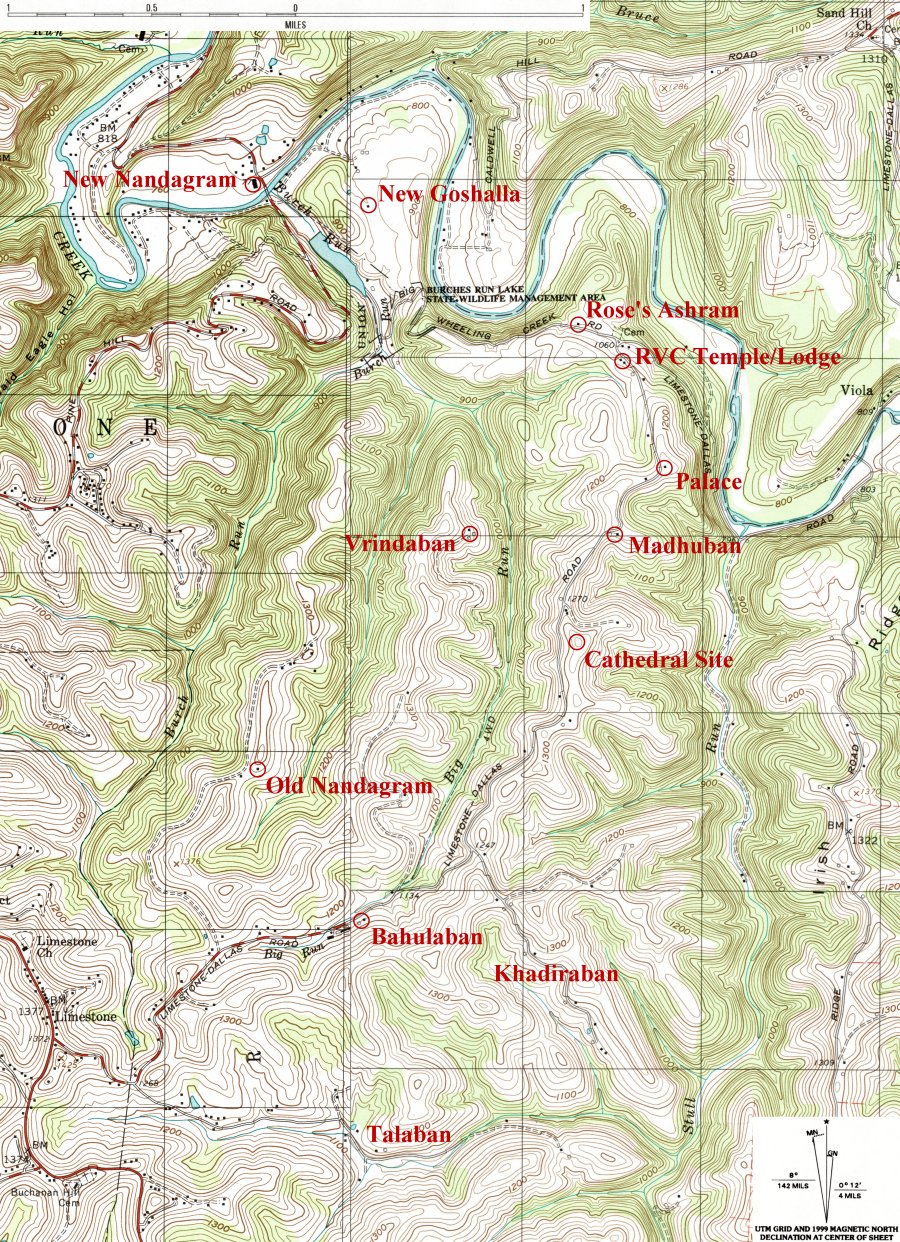
U. S. Geological Survey topographic map of McCreary Ridge showing location of principal sites of New Vrindaban.

Bhaktivedanta Swami Prabhupada in the pavilion on the hill behind Bahulaban (September 1972).
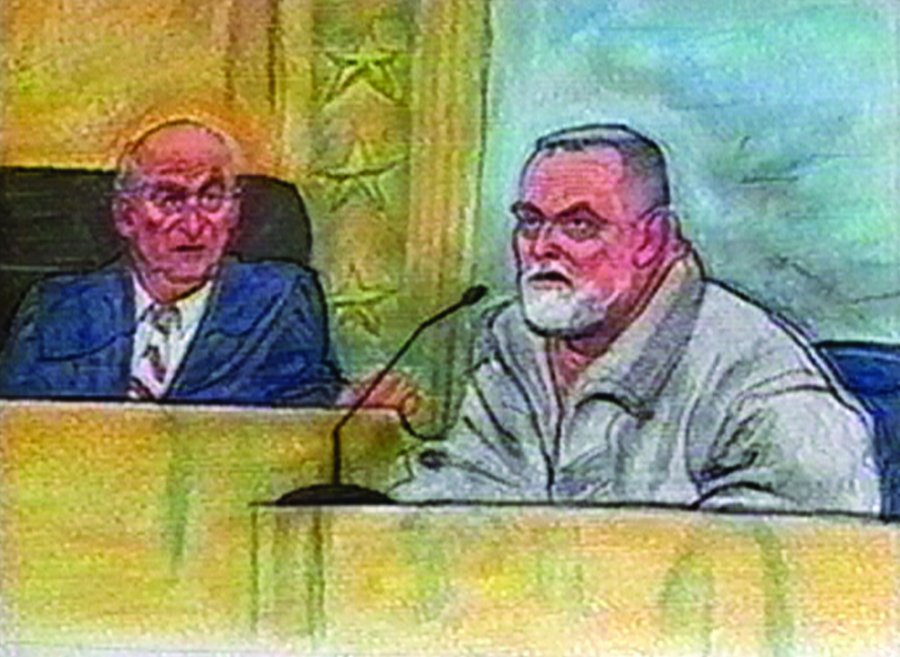
Bhaktipada in court (March 1991).

Chief prosecutor William Kolibash (undated).

Formal portrait of Bhaktipada under house arrest (c. 1992).

Formal portrait of Bhaktipada under house arrest (c. 1992).
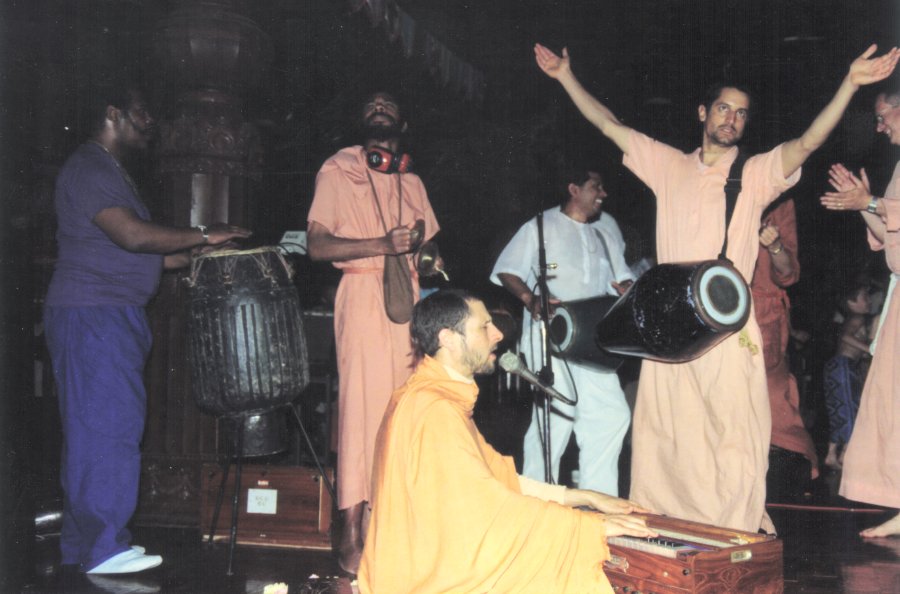
Some devotees begin rebelling against Bhaktipada’s Western Music Program. Kirtan at the RVC temple: Unkown black devotee, Kevala Bhakti, Radhanath Swami, Rupanuga, Nityodita Swami, Sri Galim.
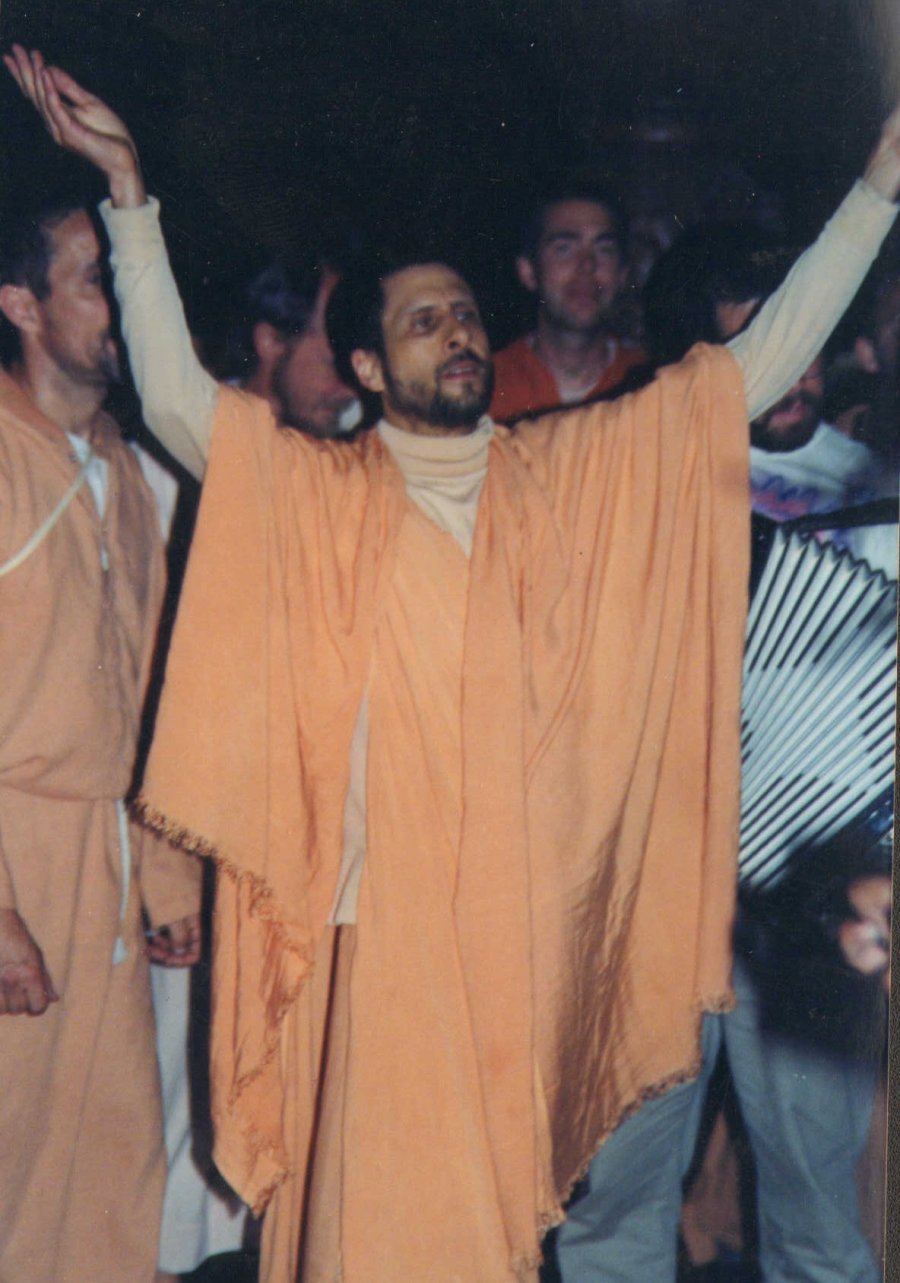
Radhanath Swami dances during kirtan (May 25, 1992).
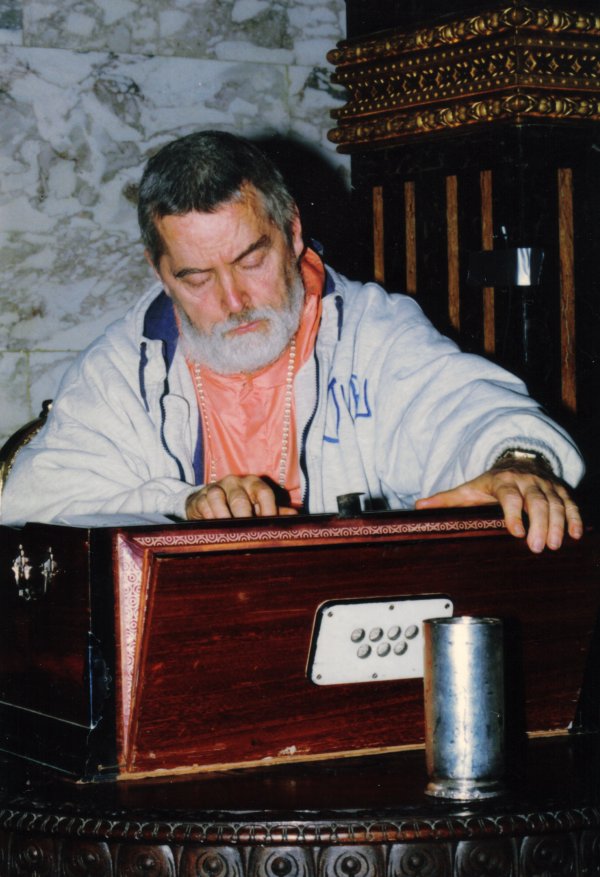
Bhaktipada surprises us all by singing the Sanskrit Samsara Prayers at Prabhupada’s Palace and accompanying himself on the harmonium during the height of the Western music/English lyrics era (May 25, 1992).

Unitarian Universalist Minister and City of God Interfaith Member Rev. George David Exoo led a protest against Bhaktipada and the “The City of Fraud” (undated).
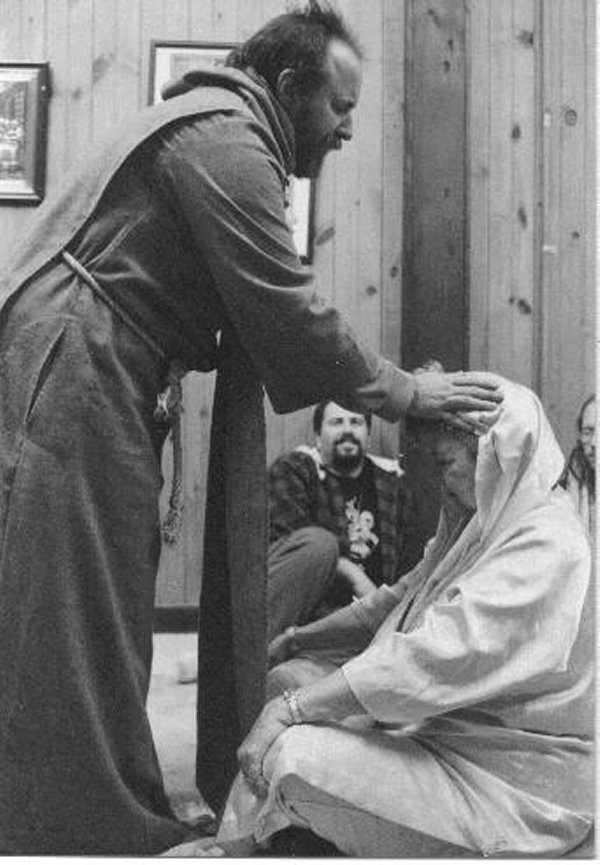
Krishna-Catholic Bhakti Ananda Goswami (David Sherman) visited New Vrindaban. Here he gives a blessing to City of God Quaker resident Sister Piety (Mary Lou Sherwood) (undated).
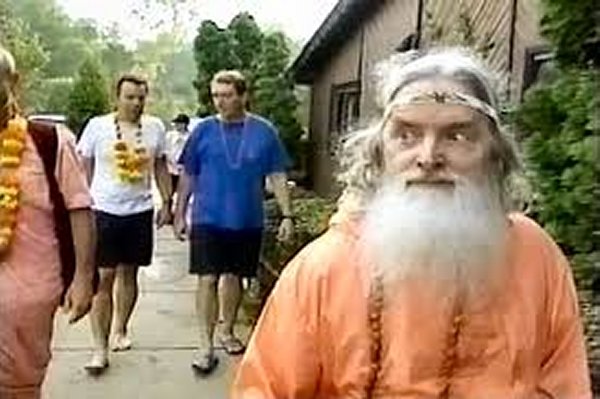
Bhaktipada, released from house arrest, returns to New Vrindaban, and prepares to enter the RVC temple to greet the deities and devotees, and give class. He is followed by important men in the community: Tapapunja Swami, Garga Rishi and Sudhanu (August 16, 1993).

Bhaktipada gives class at the RVC Temple of Understanding. “My release proves all the charges against me were false!” (August 16, 1993).

Bhaktipada (wearing his finest robe and holding a red rose and staff in his hand) and his young Malaysian servant walk through a hallway at the Parliament of the World’s Religions annual conference in Chicago, while his driver Sarvabhauma dasa lightens the solemn mood by photobombing the picture from behind (early September 1993).
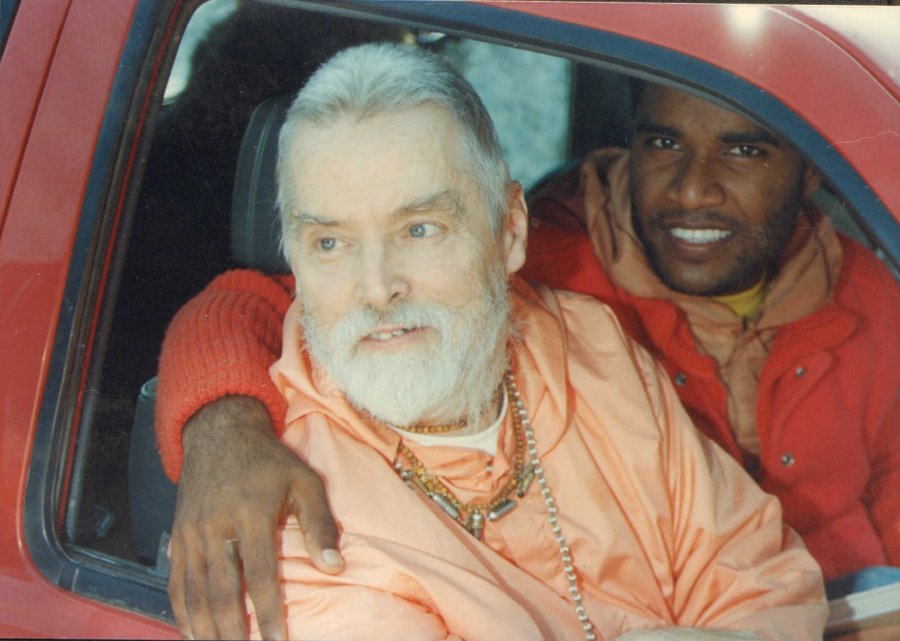
Along with his Malaysian disciple KD, Bhaktipada also showed great affection to another Malaysian disciple, LN. Here, Bhaktipada and LN sit in Bhaktipada’s vehicle at New Vrindaban (undated).
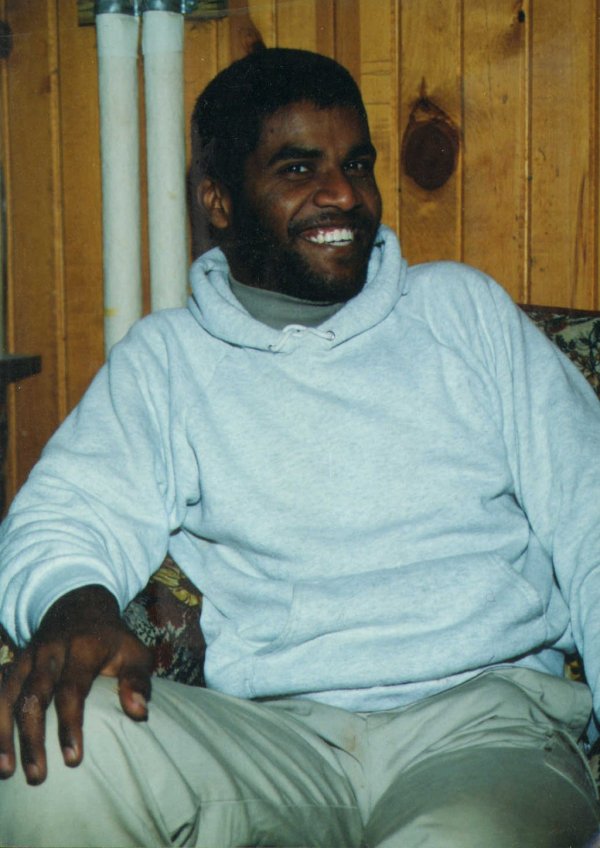
Bhaktipada’s Malaysian disciple LN at New Vrindaban (Summer 1993).
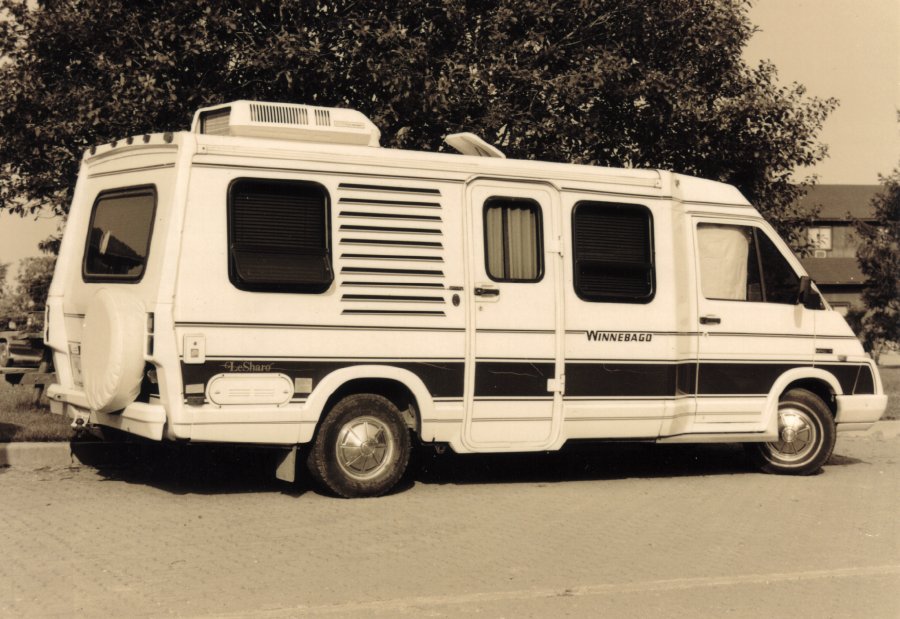
Bhaktipada’s Winnebago van in the RVC temple parking lot (undated).

Bhaktipada’s disciple and driver Sarvabhauma, on right, who witnessed his master having inappropriate relations with a male Malaysian disciple in the bed of his Winnebago van during the drive from Chicago to New Vrindaban (undated).

Devamrita Swami is the first to inquire from Bhaktipada about his behavior in his Winnebago van (photo from May 25, 1992).
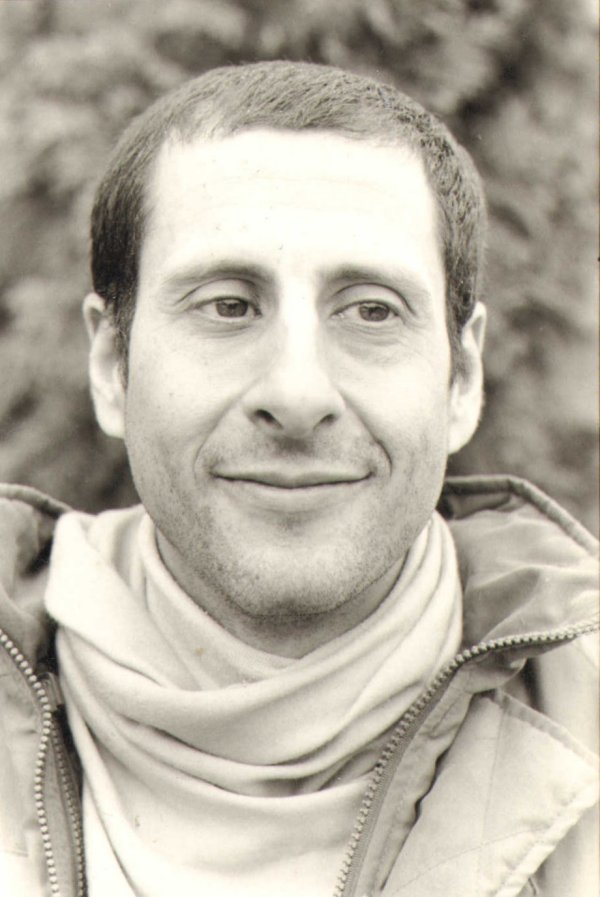
Radhanath Swami is the second to inquire from Bhaktipada about his behavior in his Winnebago van (photo undated).
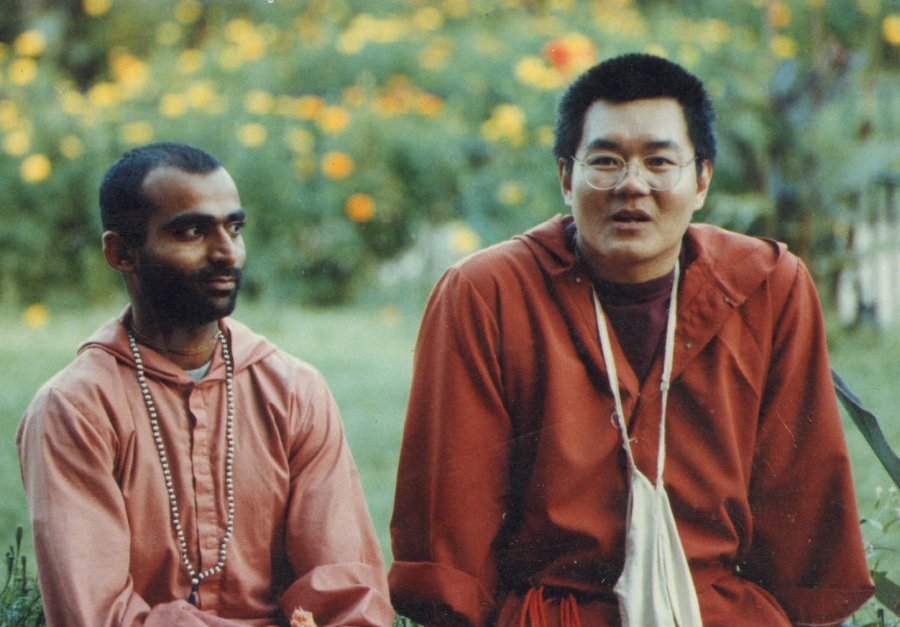
Ramananda dasa (on right) sits on the RVC temple garden iron railing with his godbrother Krishnadasa Kaviraja. Ramananada condemned those who claimed Bhaktipada had fallen from his sannyasa vows: “Coffins should be procured for the blasphemers who dared to spread slanderous lies about the spiritual master, Krishna’s pure devotee.” (photo c. September 1993).
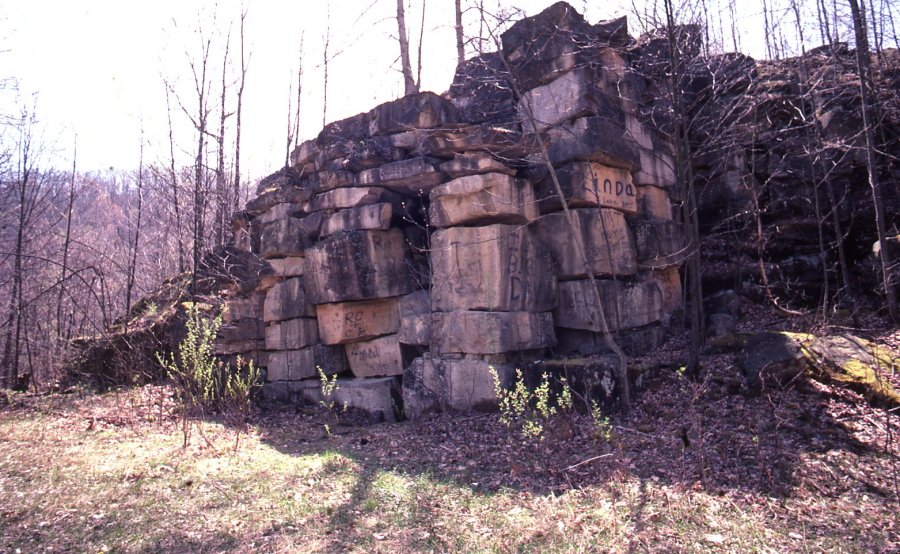
After the Winnebago Incident, Bhaktipada retires to Silent Mountain, a limestone quarry 25 miles south of New Vrindaban. He came to New Vrindaban only during the morning service to sit on his vyasasana, accept worship and give class. (undated).
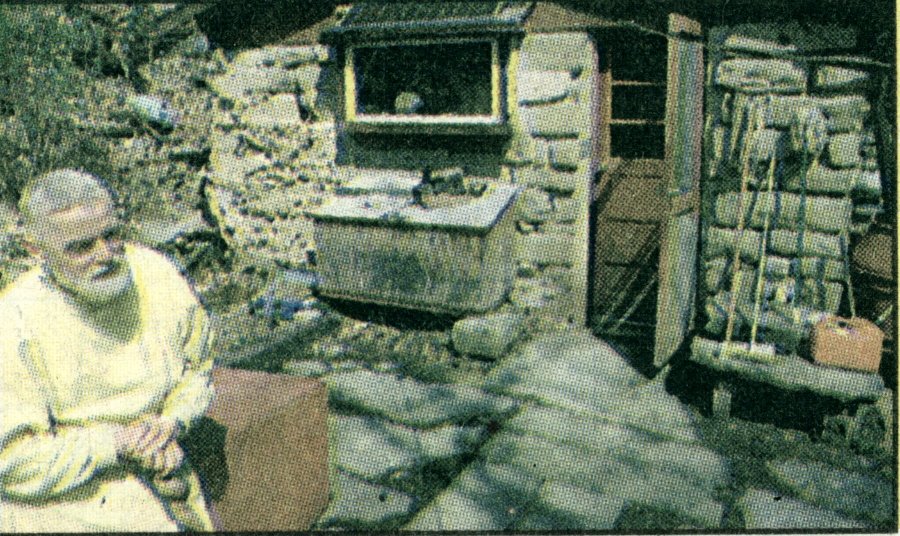
Bhaktipada outside his stone cabin at Silent Mountain (undated newspaper photo).
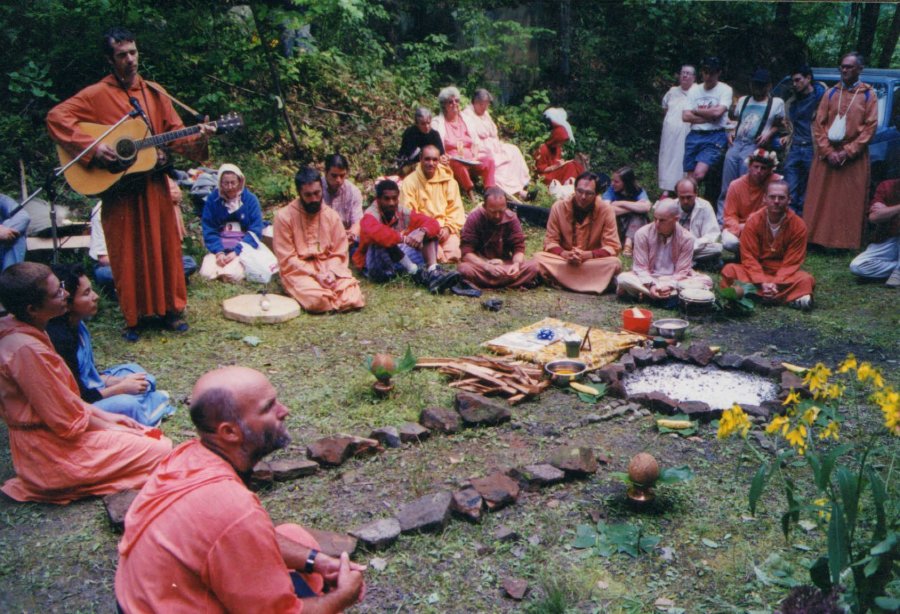
Bhaktipada’s disciples and followers prepare for a fire sacrifice at Silent Mountain during their spiritual master’s Appearance Day celebration (September 6, 1994). In this photo we see Devananda Swami (Daivata), Eternal Love Swami (Sukhavaha), Sacimata (Shirley Prins), Peaceful Swami (Denis Moreau) with guitar, Bhakti Rasa Swami (Brooke Brody), Kevala Bhakti (Carlos Nunez), Adi Purusha Swami (Ajeya), PK Swami, Vishvamurti (William Stachowski), RVC Swami. In back: Mahati (Murti Swami’s former wife), Sister Piety (Mary Lou Sherwood), Bhakti Joy, Murti dasa (Michael Dilly).

Bhaktipada’s disciples and followers chant kirtan at Silent Mountain during their spiritual master’s Appearance Day celebration (September 6, 1994). Here we see Peaceful Swami, Humble Heart (Dasarath), Sanatan Dharma (Steve Howard), Murti dasa (Michael Dilly), Bhakti Rasa Swami, Eternal Love Swami.
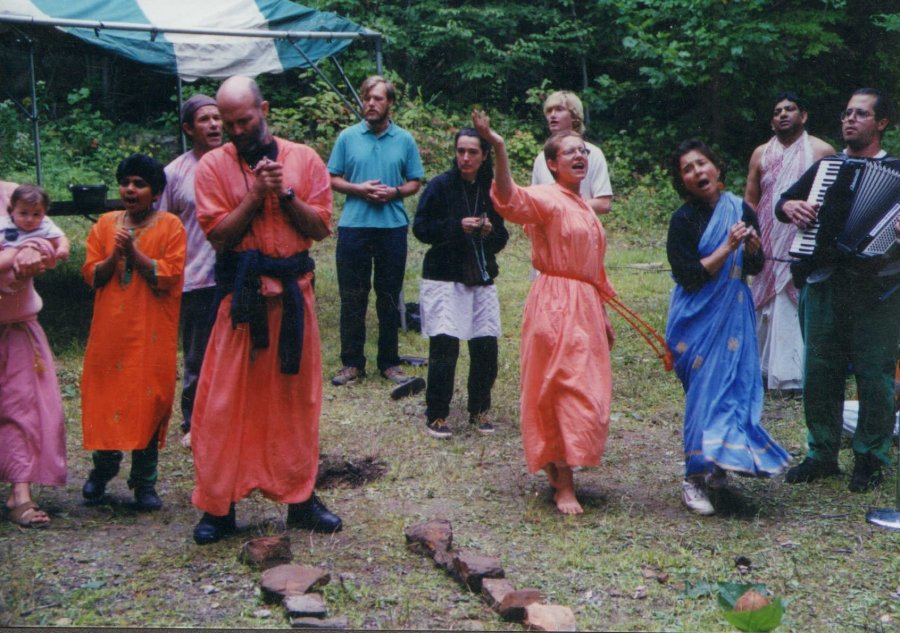
Bhaktipada’s disciples and followers chant kirtan at Silent Mountain during their spiritual master’s Appearance Day celebration (September 6, 1994). Here we see Mandakini (daughter of Hari Kirtan and Manasaganga), Sacipita (James Prins), Devananda Swami, Chakrapani, Unknown woman, Sincere Heart from England, unknown blonde, Sacimata, Hari Kirtan, Dhruva (playing accordion).
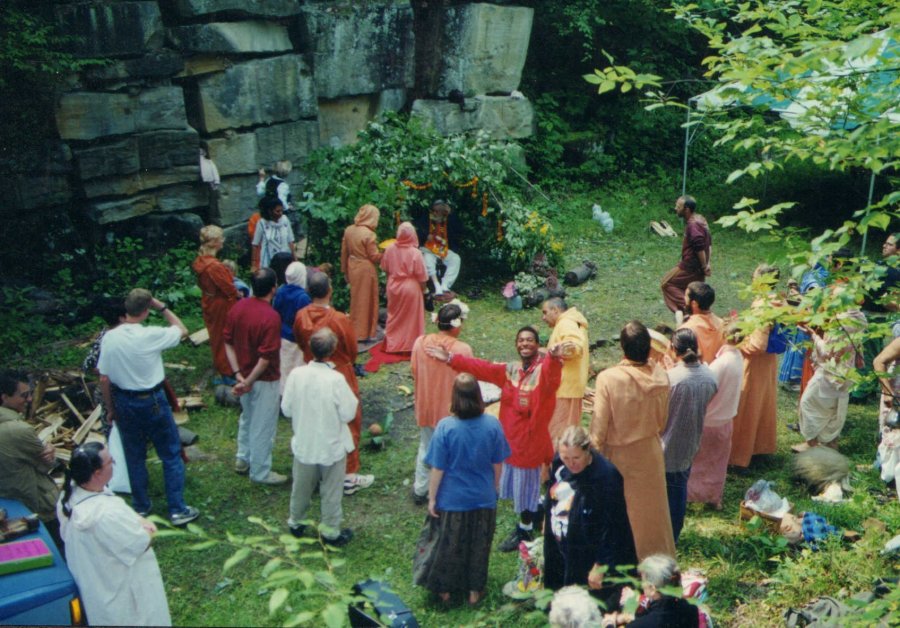
Bhaktipada’s disciples and followers celebrate their spiritual master’s Appearance Day at Silent Mountain. Bhaktipada, wearing white sweat pants, sits in a decorated bower against the cliff wall (September 6, 1994).
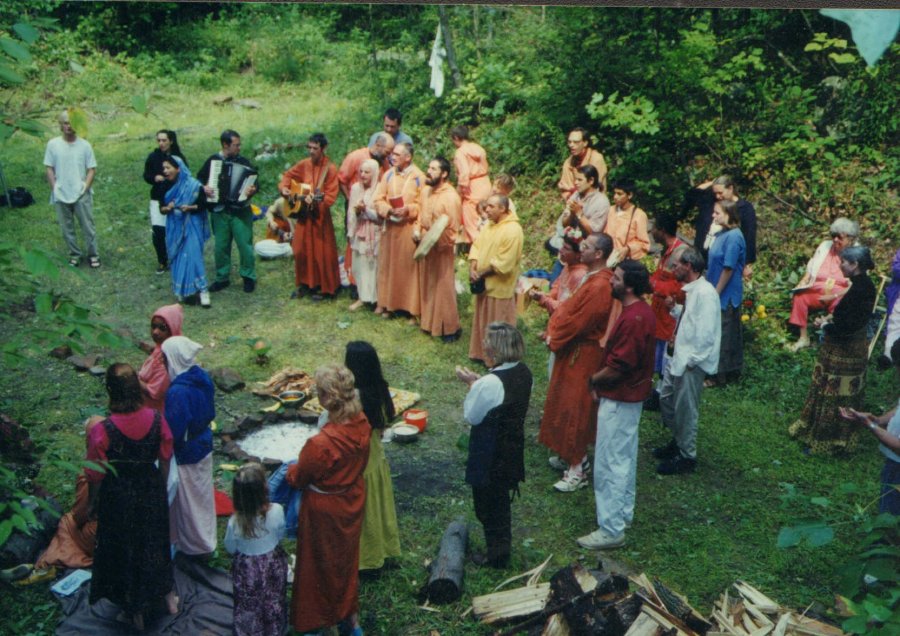
Bhaktipada’s disciples and followers praise the glories of their spiritual master at Silent Mountain on his blessed Appearance Day (September 6, 1994).
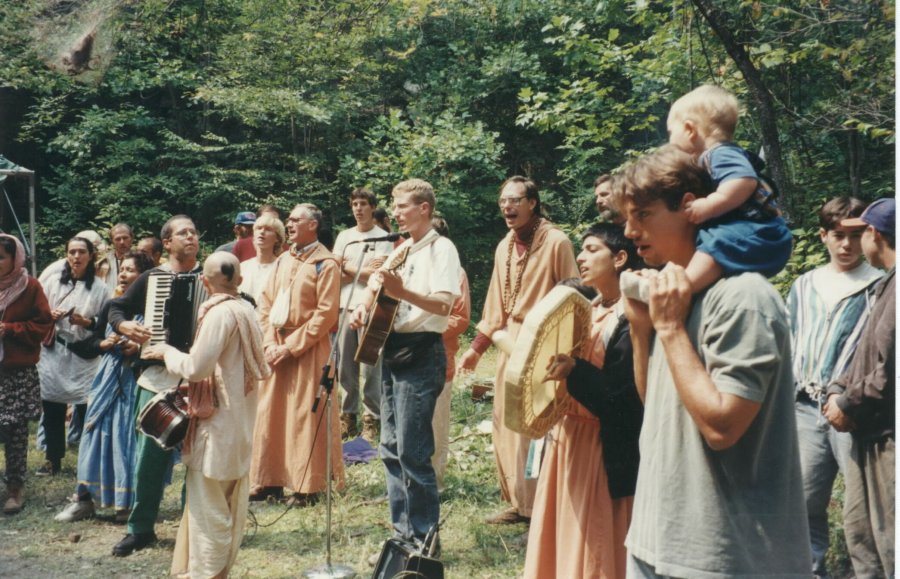
Bhaktipada’s disciples and followers praise the glories of their spiritual master at Silent Mountain on his blessed Appearance Day, including Hayagriva’s eldest son (and infant grandson): Samba (September 6, 1994).

Bhaktipada leaves the Martinsburg West Virginia Court House (April 1996).
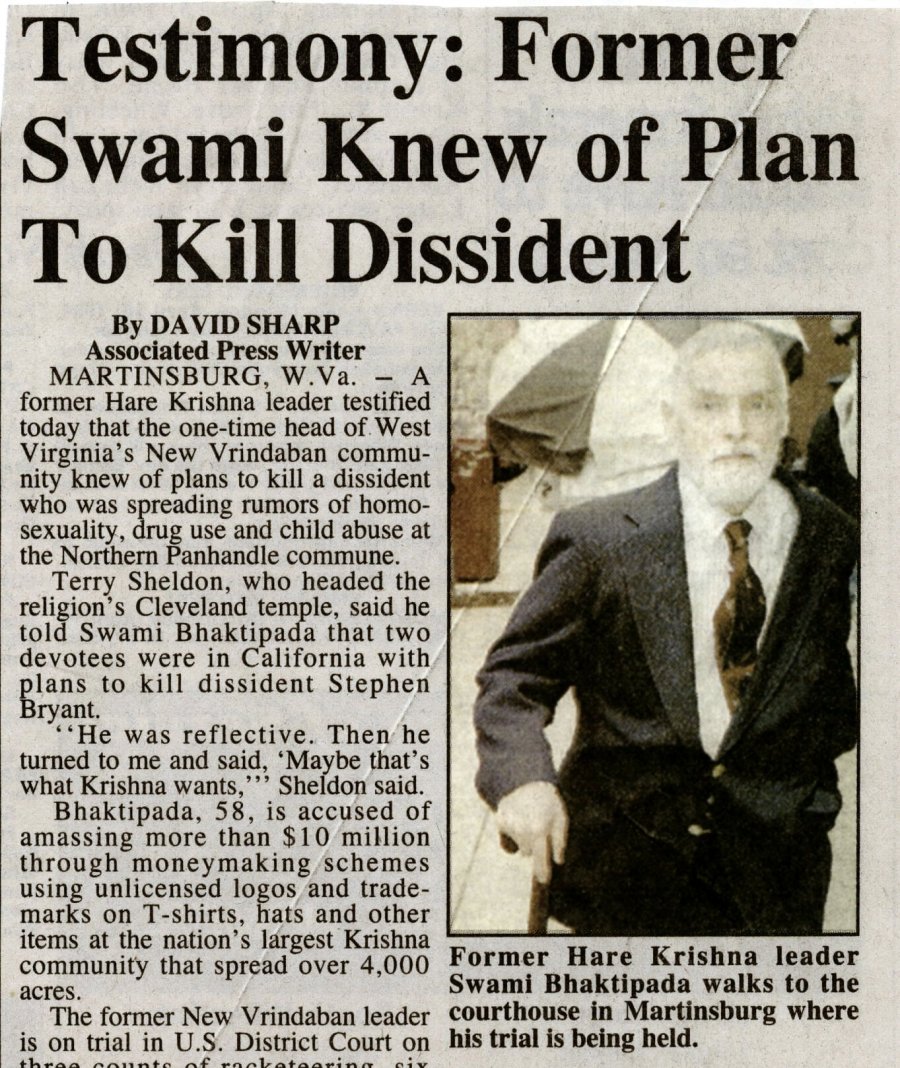
Newspaper article (April 1996).

Wheeling News Register article (December 19, 1996). It appears someone has defaced the image of Swami Bhaktipada.

Tirtha Swami blew the lid off Bhaktiada’s defense when he agreed to testify that his “spiritual master” authorized the murders of Chakdradhari (1983) and Sulochan (1986). Image from Holy Cow! Swami (undated).

Tirtha Swami in his prison cell with his Gaura Nitai deities (undated).
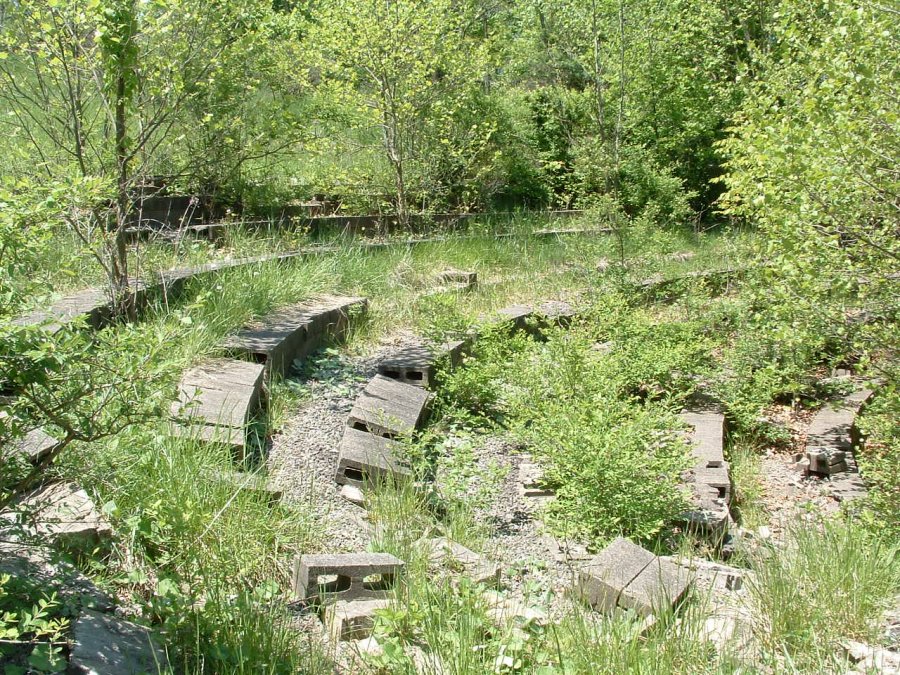
Bhaktipada left New Vrindaban in shambles. This is what’s left of the ampitheater (photo: August 2003).
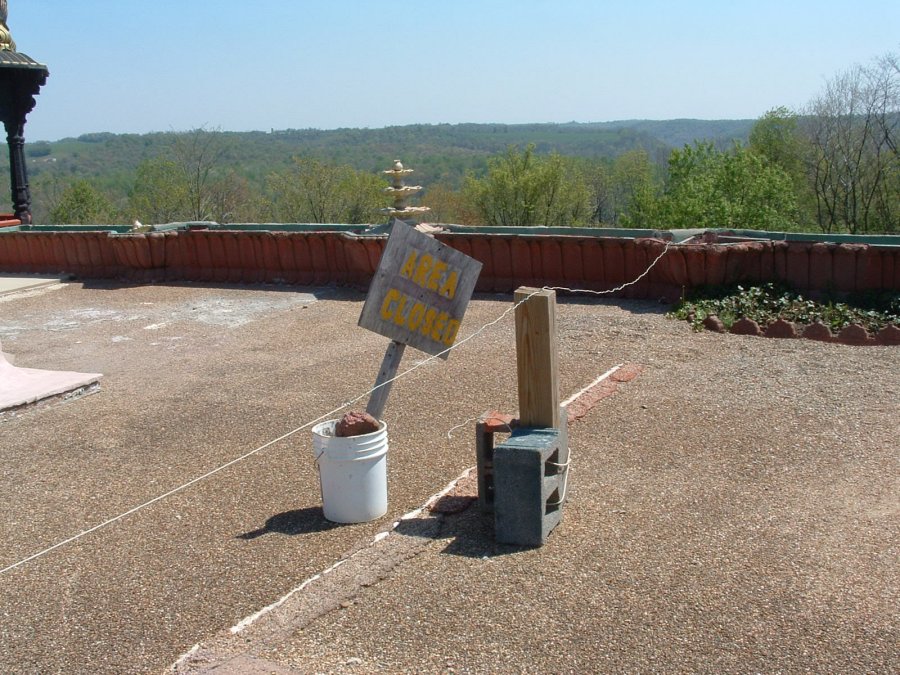
The roof over the Palace restaurant was so damaged with cracks and potholes that devotees erected a barricade and sign, “Area Closed,” to protect visitors from tripping and falling (photo: August 2003).

The two-foot long toes of the giant Prabhupada statue lay on the ground overgrown with grass (photo: August 2003).
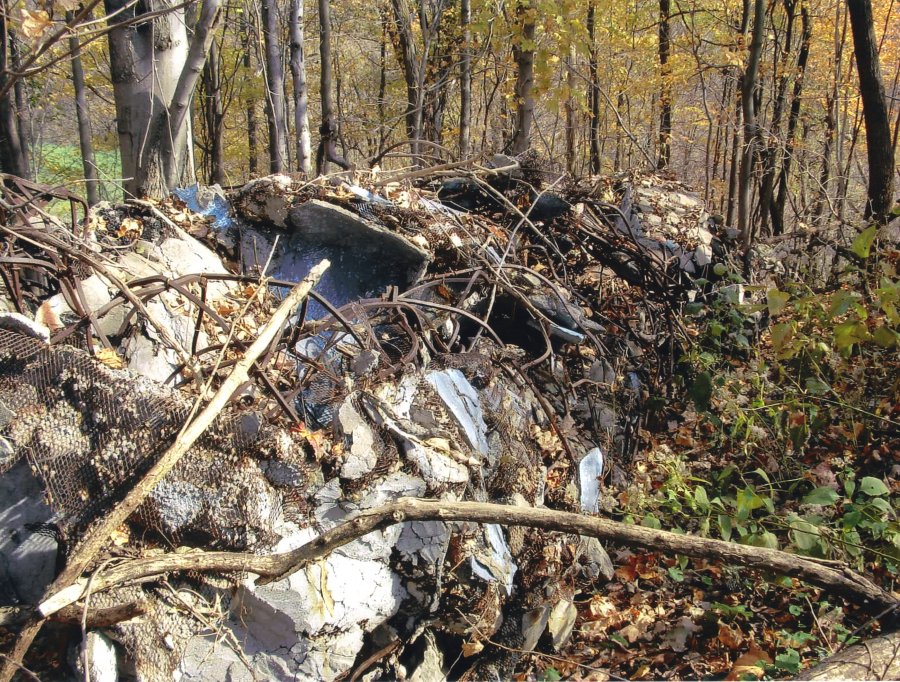
The giant Prabhupada statue was smashed into rubble by Varshan Maharaja and rolled off the edge of the plateau, where it was arrested in its fall by a large tree (photo: August 2003).
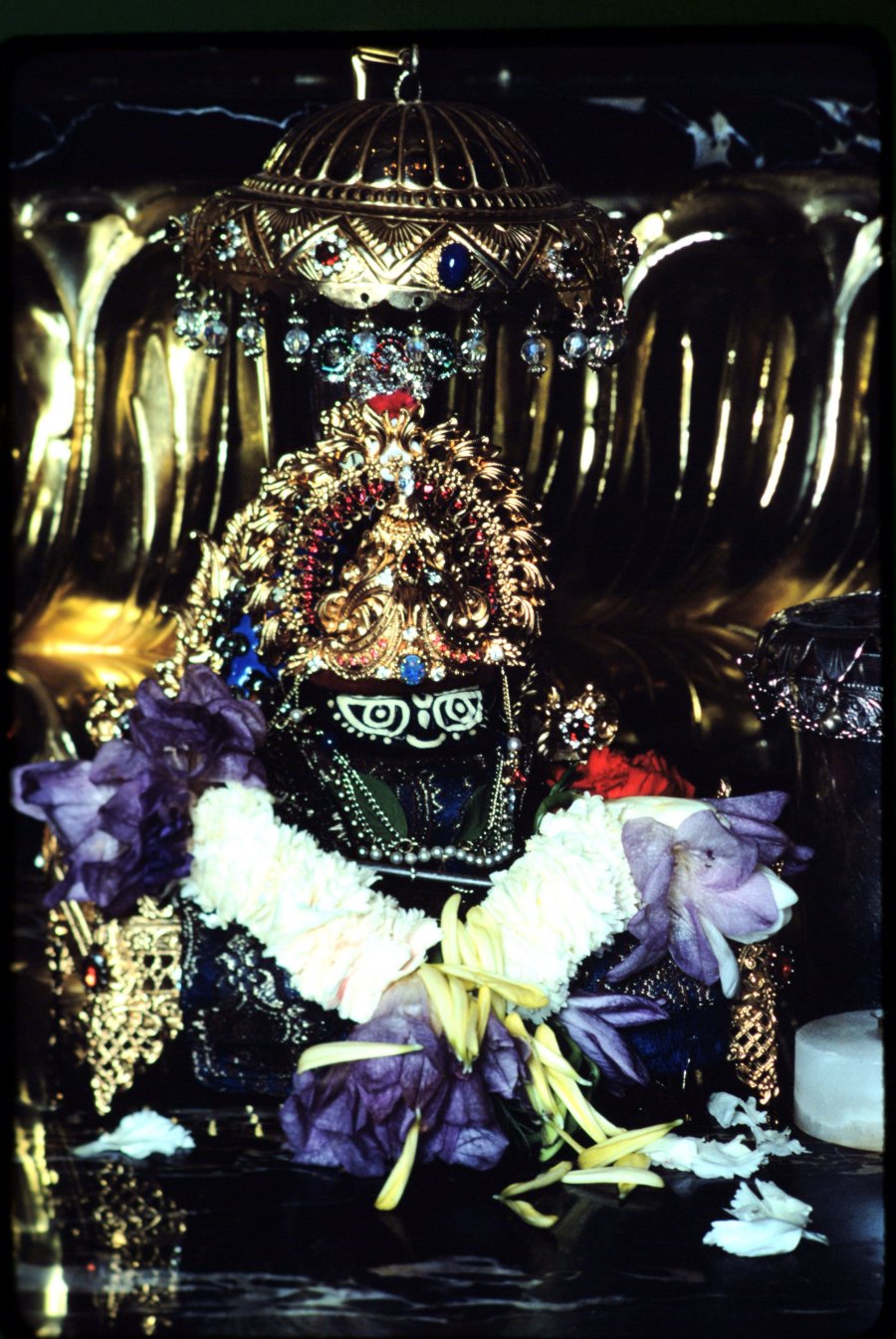
The two Salagram Silas were stolen off the altar of the RVC Temple. This photo is the sila known as Hiranyagarbha, seated on his throne, wearing crown and flower garland (c. 1980s).

The four deities, Laksman, Rama, Sita and Hanuman, were sold to the Towaco, New Jersey ISKCON temple. They were installed at New Vrindaban in November 1986.
Back to: Gold, Guns and God
